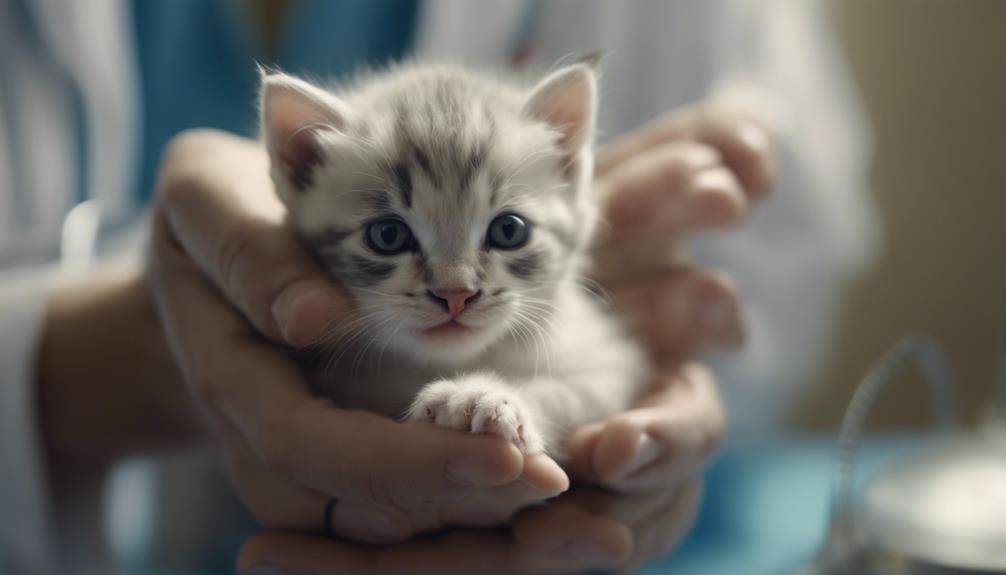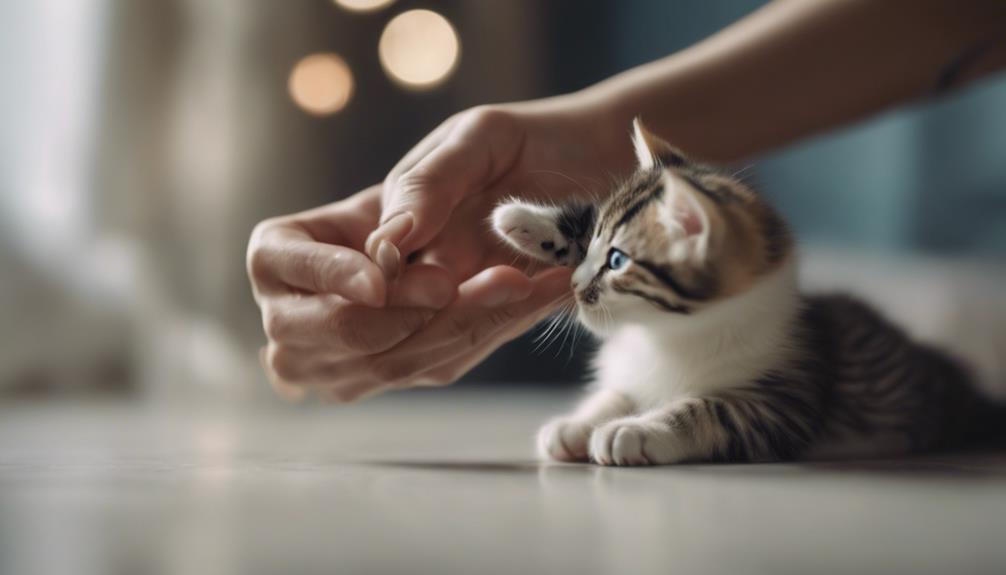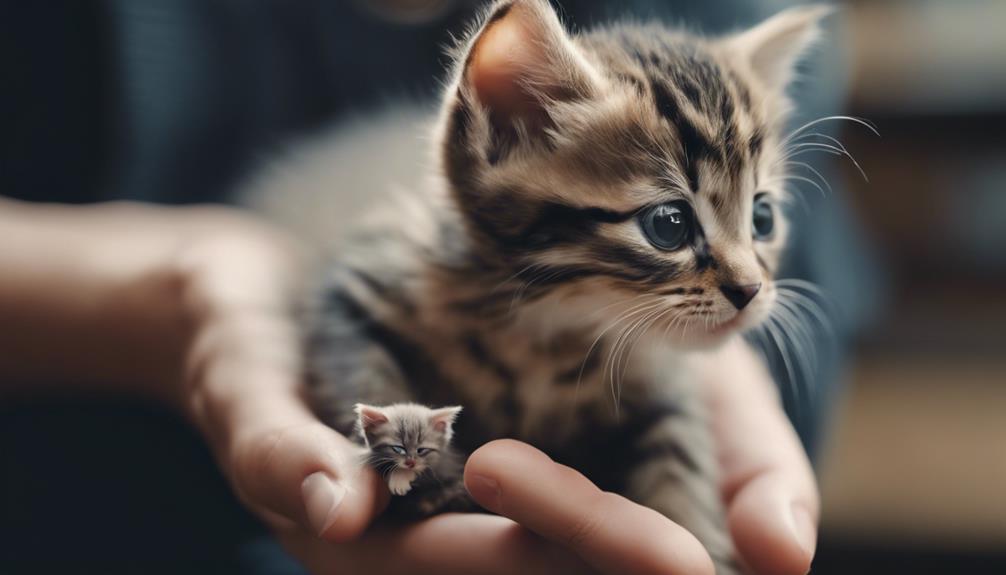When it comes to discerning the gender of a kitten, a straightforward method can prove invaluable for pet owners seeking clarity in this aspect of feline care. By focusing on subtle physical cues and employing a systematic approach, individuals can enhance their ability to determine whether a kitten is male or female with confidence.
This method, while simple in principle, holds the key to unlocking a crucial aspect of understanding and caring for these beloved companions. Let's explore how this method can shed light on the gender mystery of kittens and provide a foundation for effective pet care practices.
Key Takeaways
- Look for specific genital features like a vulva or scrotum to determine kitten gender.
- Coat color can provide clues, with calicos and tortoiseshells usually female.
- Seek guidance from a vet for confirmation and consider behavioral cues.
- Practice gentle handling and monitor changes as the kitten grows for clearer signs.
Positioning the Kitten Correctly
When determining the gender of a kitten, the first step is to position the kitten correctly to ensure a thorough examination of its genital area. Placing the kitten on a flat surface, such as a towel, and gently lifting its tail will provide better visibility.
For long-haired kittens, it may be necessary to comb away extra fur to clearly see the genital region. It is crucial to never lift a kitten by its tail during this process. By locating the anus near the base of the tail and observing for specific features like the vulva for females or the scrotum for males, one can begin to identify the kitten's gender with careful examination.
Gentle Examination of Genital Area
To ensure accurate gender determination in kittens, it is essential to conduct a gentle examination of the genital area following the proper positioning techniques previously discussed. This step is crucial in identifying the gender of a kitten correctly.
Some key points to consider during the examination include:
- Use gentle movements to avoid causing discomfort to the kitten.
- Ensure proper lighting to have a clear view of the genital area.
- Take your time to carefully observe and differentiate the features present.
Noting Specific Male Features

Observing the distinct anatomical characteristics of male kittens is essential in accurately determining their gender through physical examination. Male kittens exhibit specific features that differentiate them from females. These features include a scrotum, a rounded shape located underneath the anus, and often some fur between the anus and scrotum. As male kittens mature, their testes will grow larger, aiding in easier identification. Below is a table summarizing the key male characteristics for quick reference:
| Male Features | Description |
|---|---|
| Scrotum | Rounded shape under the anus |
| Fur Between Anus & Scrotum | Often present on males |
| Testes | Grow larger with age |
Identifying Female Characteristics
Efficiently determining the gender of a kitten involves recognizing specific anatomical features that distinguish females from males. When identifying female characteristics, look for the following:
- The vulva: A small slash or line located directly underneath the anus.
- Less fur: Females typically have little fur between the anus and vulva.
- Round shape: Females lack the second rounded shape further down, which is the scrotum found in males.
Monitoring Growth for Changes

As kittens develop, tracking changes in their physical characteristics over time can aid in accurately determining their gender. Monitoring growth for changes such as the development of secondary sexual characteristics is crucial.
For example, male kittens will experience growth in their testes as they mature, making it easier to distinguish male features. Additionally, observing the overall size and body shape of the kitten can also provide clues about its gender.
It is essential to regularly assess these changes to ensure an accurate determination of the kitten's gender. By paying attention to these developments and comparing them with established gender indicators, one can improve the accuracy of gender identification as the kitten grows.
Exercising Caution and Gentleness
When determining the gender of a kitten, it is crucial to handle the examination with utmost care and gentleness to ensure the well-being and comfort of the animal. This process can be sensitive, so following these guidelines is essential:
- Approach the kitten calmly to prevent stress
- Use gentle movements to avoid causing discomfort
- Take breaks if the kitten shows signs of distress
Seeking Professional Veterinary Advice

Seeking guidance from a qualified veterinarian is imperative when seeking accurate and reliable advice on determining the gender of a kitten. Veterinarians have the expertise and experience to properly examine the genital area of a kitten and provide an informed assessment of its gender. They can offer precise explanations and identify subtle differences that may be challenging for an untrained individual to discern.
Additionally, veterinarians can take into account other factors such as the kitten's age, health status, and behavior, which may influence the accuracy of gender determination. By consulting a professional veterinarian, you can ensure that the gender identification process is conducted safely, ethically, and with the highest level of accuracy possible.
Waiting for Clearer Signs
In the process of determining the gender of a kitten, it is advisable to exercise patience and wait for clearer signs to emerge as the kitten matures. This waiting period allows for more accurate identification and reduces the likelihood of misjudging the kitten's gender prematurely. During this time, observing the kitten's development and behavior can provide valuable insights into its gender.
- Monitor physical changes such as the growth of testes in males
- Observe any emerging gender-specific behaviors
- Pay attention to any additional physical characteristics that may become more pronounced over time
Handling Kittens With Care

Handling newborn kittens delicately is crucial to ensure their well-being and safety. When handling kittens, it is important to support their bodies properly, ensuring that their heads are well-supported and secure.
Use gentle and slow movements to prevent causing stress or injury to the fragile kittens. Always wash your hands before and after handling them to prevent the spread of germs. Avoid rough handling, sudden movements, or loud noises that could startle the kittens.
Additionally, provide a warm and comfortable environment during handling to keep the kittens calm and relaxed. By practicing careful and gentle handling techniques, you can help create a safe and comfortable experience for the newborn kittens, promoting their health and well-being.
Observing Behavioral Cues
When observing kittens, attentively noting their behavioral cues can provide valuable insights into their temperaments and personalities. Understanding how kittens interact with their environment and with humans can offer hints about their gender.
Here are three key behavioral cues to consider:
- Playfulness: Female kittens often display more agility and speed during play sessions, while male kittens might exhibit more rough-and-tumble behavior.
- Affection: Female kittens tend to seek more cuddles and affection from their human caregivers, whereas male kittens may be more independent but enjoy interactive play.
- Vocalization: Female kittens may have softer and more melodious meows, while male kittens might have louder and more assertive vocalizations.
Understanding Gender Determination Challenges
Determining the gender of a kitten can present various challenges due to the subtle physical and behavioral indicators required for accurate identification. Physical examination techniques, such as checking for the presence of a vulva or scrotum, can be complicated by factors like fur thickness or the kitten's age.
Additionally, behavioral cues may not always align with traditional gender stereotypes, further complicating the identification process. Factors such as the kitten's size, age, and health can also impact the accuracy of gender determination.
It is essential to approach gender identification with caution and seek advice from a veterinarian when in doubt. Understanding the potential difficulties in determining a kitten's gender can help individuals navigate these challenges more effectively.
Factors Affecting Accuracy
Understanding the nuances of physical and behavioral indicators is crucial in recognizing the factors that can influence the accuracy of determining a kitten's gender. Factors affecting accuracy include:
- Age: Gender characteristics may not be fully developed in very young kittens, making it harder to determine.
- Coat Length: Longer fur can obscure the genital area, leading to potential misinterpretation.
- Health Conditions: Certain health issues, such as obesity or infections, can distort the appearance of genital features, affecting identification accuracy.
These factors highlight the importance of considering multiple aspects when determining a kitten's gender to ensure a more precise assessment.
Strategies for Overcoming Difficulties

Strategies for overcoming challenges in determining the gender of kittens involve careful observation and consideration of various factors that may impact the accuracy of gender identification. One effective strategy is to seek guidance from a veterinarian for professional confirmation. Waiting until kittens are older can also provide clearer signs for gender determination.
Additionally, practicing gentle handling techniques during examinations can help reduce stress for the kittens, making it easier to identify gender-specific features. Considering behavioral cues as hints for gender can further aid in the identification process. Understanding that gender determination may be challenging and being patient with the process are crucial elements in successfully overcoming difficulties in determining the gender of kittens.
Practical Steps in Gender Determination
To successfully determine the gender of kittens, it is essential to carefully position the kitten and conduct a thorough examination of its genital area while noting specific features indicative of male or female characteristics.
Here are some practical steps to assist in gender determination:
- Ensure proper positioning of the kitten.
- Examine the genital area carefully.
- Note specific features for males and females.
Frequently Asked Questions
Can a Kitten's Gender Change as It Grows Older?
A kitten's gender does not change as it grows older. While physical characteristics may become more distinct with age, the gender remains constant. Seeking professional advice and monitoring developmental changes are essential for accurate gender determination.
Are There Any Non-Physical Signs That Can Indicate a Kitten's Gender?
Non-physical signs indicating a kitten's gender may include personality traits or behavior tendencies. Males may exhibit more territorial or dominant behaviors, while females can display maternal instincts. These cues, along with physical characteristics, can help determine gender.
How Can the Color of a Kitten's Coat Affect Its Gender Identification?
The color of a kitten's coat can sometimes provide clues to its gender. Calicos and tortoiseshells are often female, while approximately 3 in 4 orange tabby cats are male. Coat color patterns are influenced by sex-linked genes.
Is It Possible for a Kitten to Have Both Male and Female Reproductive Organs?
It is possible for kittens to have both male and female reproductive organs, a condition known as hermaphroditism. This rare occurrence can result in ambiguous genitalia, requiring veterinary assistance for accurate gender determination and potential surgical intervention.
Are There Any Specific Age Milestones When It Becomes Easier to Determine a Kitten's Gender?
Determining a kitten's gender becomes easier with age due to the development of more pronounced male features. Seeking guidance from a veterinarian, monitoring changes as the kitten grows, and understanding behavioral cues can aid in accurate gender identification.
Can Sneezing in Kittens be Related to Their Gender?
When it comes to understanding why kittens sneeze remedies, there is no evidence to suggest that sneezing is related to their gender. Sneezing in kittens can be due to various factors such as infections, allergies, or environmental irritants. It’s important to consult a veterinarian to determine the cause and proper treatment for sneezing in kittens.
Conclusion
In conclusion, accurately determining the gender of a kitten is crucial for their proper care and understanding of their unique needs.
By following the outlined steps and paying attention to specific features, pet owners can confidently identify whether their kitten is male or female.
Seeking professional guidance when needed and being aware of potential challenges in gender determination will ensure that kittens receive the appropriate care and attention they require.




